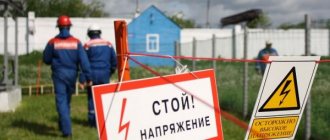Carrying out electrical work is a rather complex and dangerous procedure. Therefore, when performing such work, it is important to have the skills and experience to prevent emergency situations, violations of work technology and errors that can harm a person. Training, testing of knowledge in the field of electrical safety and obtaining an appropriate certificate by enterprise employees is a prerequisite for starting work, both for electrical and non-electrical personnel.
Categories of personnel in electrical safety
The main categories into which personnel are divided to obtain permission to work with electrical installations are:
- Electrotechnical;
- Electrotechnological;
- Not electrical.
Electrotechnological - personnel of production departments that work on electrical devices (electric ovens, electric welding, electrolysis and others), the work of which requires constant maintenance and adjustment of electrical equipment, electric drives, hand-held electrical machines, portable and mobile power receivers, portable power tools.
Non-electrical workers include workers whose activities involve interacting with various household appliances, simple electrical equipment and office equipment. Such workers are assigned electrical safety group I or II.
According to clause 1.4.1 of the PTEEP, the operation of electrical installations must be carried out by trained electrical personnel of the enterprise, who are divided into categories:
- administrative and technical;
- repair;
- operational;
- operational repair.
Administrative and technical
Specialists who organize the work process and manage the installation, configuration, maintenance and operation of electrical equipment.
Repair
Responsible for maintenance and repair of equipment, performs commissioning and commissioning.
Operational
Workers inspecting and monitoring electrical equipment perform prompt switching on, off, and switching of various electrical equipment in electrical installations. Responsible for permission to work in electrical installations.
Operational and repair
Personnel who monitor, maintain and repair electrical equipment that is assigned to this group;
Check of knowledge
Testing the knowledge of electrical engineering personnel is mandatory. It is primary when employment occurs. Another reason for its organization is a break in certification of more than 3 years. Inspections are carried out periodically. If these activities are carried out once a year, then their tasks include:
- organization and maintenance of electrical units;
- installation, adjustment, repair.
Administrative and technical specialists performing installation inspections are inspected every 3 years. An extraordinary event is held in the event of new standards, the operation of new equipment, or when transferring to a new position. Procedures are also required at the request of regulatory authorities.
Knowledge testing is carried out by a commission, which is created on the basis of instructions from management. There must be at least 5 people in it. The chairman must have a 5th group. He can be replaced by a responsible employee. During the knowledge test there must be at least 3 commission members. Moreover, there must be a chairman, but his deputy is also allowed to work.
When the inspection is completed, employees are assigned to a group of electrical engineering personnel. This is noted on the certificate. Only after this the employee is allowed to perform his duties. He must follow all instructions, otherwise he will be held liable for violations.
What and how many electrical safety groups are there?
In accordance with the PTEEP on electrical safety, five qualification groups are assigned for personnel interacting with and servicing electrical equipment.
Group I is established for non-electrical personnel who, in their activities, use power tools and equipment that do not require special training to work with them. This group is assigned to an employee of an enterprise who has at least electrical safety group III and higher.
Group II is assigned to workers servicing electrical devices and working on them. These include lifting machine operators, electric welders, and other specialists whose work involves the use and maintenance of portable electrical equipment employed on the territory of the enterprise. This group is also established for newly hired electrical personnel (electricians and others).
Group III is established for electrical personnel working in networks with voltages up to 1000 V and over 1000 V. Personnel with this group are allowed to independently service electrical installations and equipment, including its inspection, connection and disconnection.
Group IV is assigned to a person from among the engineering and technical workers who is responsible for electrical facilities up to 1000 V at the enterprise. Also, this group can be assigned to operational electrical personnel for training newly hired workers or those with little experience.
Group V is established for specialists (engineering engineers) who are responsible in the organization for electrical equipment over 1000 V. They can also supervise the production of electrical installation work and work on equipment up to 1000 V.
Staff Responsibilities
Electrotechnological personnel are workers who differ in a number of characteristics. They perform electrical energy management. Their activities, for example, relate to electric welding and electrolysis.
Which personnel are classified as electrical technologists? These are workers who carry out activities with portable power tools, electric hand-held machines, and lamps. What other personnel are classified as electrical technologists? These are employees not related to the energy department of the enterprise who have 2 gr. and higher. Their rights and responsibilities are approximately the same as those of electrical personnel.
What you need to know about obtaining an electrical safety clearance group
Each electrical safety group requires specific knowledge, skills and experience to work on electrical installations. Therefore, in order to obtain an ES group and permission to work, you must undergo training and obtain permission to work. There is a certain procedure for assigning an electrical safety group to an employee.
Group I is assigned after undergoing instruction on the rules of working on electrical equipment and providing first aid in case of electric shock.
Group II requires workers to have special knowledge about the structure and operating principle of electrical equipment, safe work when working with power tools, as well as the consequences of electric shock and ways to provide assistance to victims of this phenomenon.
Group III is assigned only to electrical workers who have worked for 1 to 3 months at the enterprise. Such an employee must have knowledge of the design and principle of operation and maintenance of equipment, be able to monitor the progress of electrical work, be able to identify malfunctions and safety violations, and also provide assistance to victims of electric shock.
Group IV is received by specialists who have worked for 3 to 6 months with a confirmed III group and who have secondary vocational or higher education. This employee must be able to monitor and manage the production process, provide instructions, provide assistance, and also have serious knowledge in the field of maintenance, repair and operation of electrical installations for various purposes.
Group V is assigned to a specialist who has worked with Group IV from 3 months to two years, must know electrical installation diagrams, rules for using protective equipment and checking them, and operating rules for equipment. Also, an applicant for this group must be able to organize and manage work on electrical equipment with any voltage, be able to train personnel in labor safety rules, practical methods of providing first aid to victims at work, and be able to practically provide it.
How a group is assigned
Certification for permission to work in the second electrical safety group is carried out in accordance with regulations. For this purpose, a commission is created on the basis of an administrative document. Each member of the AC must have permission recorded in the certificate. A time is set for taking the exams and the opportunity to prepare is provided.
Where do they take the electrical safety group?
The exam is carried out at the enterprise, but only if there is a certificate to conduct it. If it is not possible to take tests on your own, then certification is carried out in specialized training centers that have permission to engage in this type of activity.
Who can take the exam
Knowledge testing is carried out on a commission basis. The minimum number of members must be at least three, including the chairman.
Basic conditions for creating a commission:
- If there are electricity receivers with a voltage of less than 1000 V, the chairman must have at least clearance group IV.
- If the voltage indicator is more than 1000 V, then the group assigned to the chairman must be at least V.
- The commission may include production site managers and occupational safety specialists.
- All members of the commission must have an electrical safety group of at least second.
- Certification of the chairman and members is carried out at Rostechnadzor or at the enterprise, but in the presence of an inspector.
Exam program for obtaining admission
Training is carried out according to the Program developed at the enterprise and approved by Rostechnadzor.
The training includes the following materials:
- Primary requirements.
- How is permission to work granted?
- List of technical documentation required for work.
- Concepts about electrical safety groups.
- Occupational health and safety during work.
- Actions in case of emergency situations: accident, incident, accident.
- Provide first aid until medical professionals arrive.
When preparing a program, you can use a standard one, and also take into account the specific capabilities of the organizational structure.
Training
Electrical Safety Exam
Knowledge is checked by commission and admission options are as follows:
- In the enterprise organization commission.
- In a specialized training center, and the composition should include an inspector from Rostekhnadzor, who monitors the safety during the operation of technical devices.
- Directly in RTN, geographically located.
The management of the organization appoints commission members to conduct certification. The chairman, as a rule, is the employee responsible for the energy management of the facility. All members of the commission must have certificates with a mark of certification.
Knowledge testing is carried out using tickets specially designed for the Training Program. Upon successful completion of the test, an entry is made in the protocol and a certificate is issued. If the certification is repeated, then a record of its completion is made.
Knowledge test result
The results of testing the knowledge and skills of employees are prepared according to the following algorithm:
- The training center of the enterprise or a third-party organizational structure approves the form of the protocol and certificate. The established forms of documents are placed in regulations.
- Information about passing tests is entered into the journal.
- Data on the inspection performed are recorded in the protocol: the employee’s surname and initials, job title, which electrical safety group was assigned, when the next certification is required.
- The results of passing the tests are entered in the certificate: the document number, the name of the enterprise, the surname and initials of the employee in full, his position when the document was issued are indicated; the date of the knowledge assessment, the reason for the event, which group was assigned, the assessment, the deadline for the next certification is indicated.
The certificate is issued to the employee.
Duration and price of training for electrical safety approval
| Electrical safety approval group | Academic hours | Course price (in rub.) | Timeframe for obtaining admission (in working days) |
| 2 to 1000V | 72 | 4500 | 7 |
| 3 to 1000V | 72 | 4500 | 7 |
| 3 up to and above 1000V | 40 | 5000 | 7-10 |
| 4 to 1000V | 72 | 5000 | 7-10 |
| 4 up to and above 1000V | 40 | 5000 | 7-10 |
| 5 up to and above 1000V | 40 | 5000 | up to 7 |
How is it different from electrical engineering?
The difference between electrical and non-electrical personnel lies in direct contact while working with complex technical units that are under the influence of electric current, require special handling skills, and can also cause irreparable harm to health.
Non-electrical personnel, if they interact with equipment, do so only as operators; they do not carry out preventive maintenance and repairs, and do not directly interact with dangerous currents.
Employees of the electrical engineering group must undergo several types of briefings, receive the appropriate document before work - a work permit, and also undergo specialized training in training centers or educational institutions.
Also different is the use of personal protective equipment and other protective factors during work involving the risk of injury or other harm.
Another difference is the very nature of the equipment: if for non-electrical workers it most often acts as office or household equipment, then for electrical personnel it is most often complex industrial equipment, electrical networks and other complex units, the work with which requires special skills and abilities.
Do I need to obtain an electrical safety permit?
When carrying out routine activities with non-hazardous equipment, there is no requirement to obtain an electrical safety clearance for non-electrical personnel.
There is no such requirement in federal legislation, since there is no obligation or special knowledge when performing work functions with office equipment that does not have high voltage.
However, if an employee is assigned to operate dangerous devices that are under the influence of electric current and may pose a danger to life, in addition to undergoing training procedures, such an employee must also receive the appropriate permit, however, he will be transferred to another group of personnel.
List of positions to which group 1 is assigned
At the request of the manager, in case of production necessity, non-electrical personnel may be assigned 1 electrical safety group.
The list of positions that belong to group 1 of electrical safety is approved by the management team, based on the nature of the work performed.
When interacting with electrical devices on a daily basis, for example, in the office, an employee can receive this group by undergoing appropriate training and instruction from a responsible occupational safety specialist, which will give him both rights and responsibilities.
To assign electrical safety category 1, it is necessary to issue an appropriate order for the organization and carry out appropriate personnel training with this document in the form of briefings.
After this, another order should be issued to assign the appropriate category listing the positions and personal data of the employees.
For whom is it necessary to assign group 2?
There are often cases when workers, due to their immediate duties, encounter devices in their work activities that may pose an increased danger.
For such cases, assignment to a higher category 2 is required. The procedure is similar to the first one - issuing an order and conducting training events, however, the employee’s knowledge must be deeper and take into account the specifics of the enterprise’s activities.
To do this, you need to undergo appropriate training at a training center, and then certification of knowledge and receive a standard certificate.
At the same time, the frequency of training must also be observed, which the employee must undergo at least once every three years.
The initiator of obtaining group 2 admission must be the employer due to the correspondence between the citizen’s job duties and his functions in the organization.
Staff Responsibilities
Electrotechnological personnel are workers who differ in a number of characteristics. They perform electrical energy management. Their activities, for example, relate to electric welding and electrolysis.
Which personnel are classified as electrical technologists? These are workers who carry out activities with portable power tools, electric hand-held machines, and lamps. What other personnel are classified as electrical technologists? These are employees not related to the energy department of the enterprise who have 2 gr. and higher. Their rights and responsibilities are approximately the same as those of electrical personnel.
Electrotechnological personnel
Workers in this category are distinguished by a number of characteristics. First of all, the electrical engineering personnel includes employees for whom electrical energy is a key component of the processes controlled by them. Their activities, for example, may be associated with electric welding, electrolysis, the operation of electric arc furnaces, etc. The list of electrical technological personnel also includes employees who use portable power tools, electric hand-held machines, lamps and other workers for whom knowledge of industrial equipment is established in the job description. Employees who do not belong to the energy department of the enterprise and have II gr. and above, obey him. At the same time, in their duties and rights they are equal to electrical personnel.
Check of knowledge
Testing the knowledge of electrical engineering personnel is mandatory. It is primary when employment occurs. Another reason for its organization is a break in certification of more than 3 years. Inspections are carried out periodically. If these activities are carried out once a year, then their tasks include:
- organization and maintenance of electrical units;
- installation, adjustment, repair.
Administrative and technical specialists performing installation inspections are inspected every 3 years. An extraordinary event is held in the event of new standards, the operation of new equipment, or when transferring to a new position. Procedures are also required at the request of regulatory authorities.
Knowledge testing is carried out by a commission, which is created on the basis of instructions from management. There must be at least 5 people in it. The chairman must have a 5th group. He can be replaced by a responsible employee. During the knowledge test there must be at least 3 commission members. Moreover, there must be a chairman, but his deputy is also allowed to work.
When the inspection is completed, employees are assigned to a group of electrical engineering personnel. This is noted on the certificate. Only after this the employee is allowed to perform his duties. He must follow all instructions, otherwise he will be held liable for violations.










